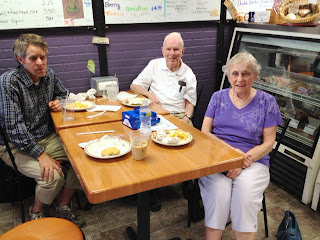Armchair Adventures
Published Aug. 5, 2012
by Paul Sullivan
Haven't We Met Before?
If I met a
guy in a bar and he asked where I was from and I said, "The South
Pole," I guarantee he'd tell me he grew up two blocks from there.
That's what
a small world it is.
Everybody
has their 'small world' stories.
Sometimes
it seems that no matter where I go, I meet somebody from Fredericksburg.
And if they aren't from there, their cousin or next door neighbor is.
At the
moment I'm in Prescott, and that's
about 2,200 miles from home base in Spotsylvania.
So the day
after I get here I'm heading out to check the mailbox. (It's always full of
junk mail when I've been gone a couple of months.) A neighbor across the street
says 'hello.'
I return
the greeting and she stops to chat.
Now I've
spoken to this neighbor a number of times and never took much notice of her
accented English. This morning I cannot help notice that it is quite Irish. I
don't want to ask her about it directly so, instead, I mention that I've just
gotten back from a trip to Ireland.
Well, you
can imagine how her face lit up. She tells me that she's from Limerick,
a city in southwest Ireland.
Oops! I
hated to have to say that we had deliberately chosen to drive around that city
on the bypass, to avoid the traffic.
Once upon a
time on a solo trip to Alaska in
1995, I had camped in a remote, deserted campground. Next morning, I continued
my drive across that country's outback.
I'd only had instant coffee and toast for breakfast so, when
I rounded a curve and spotted a small bar-and-café, complete with curling smoke
rising from its chimney, I stopped for breakfast.
It was a
friendly local place, well off the beaten tourist track, and a smiling young
lady put a steaming mug of coffee in front of me and asked what I'd like to
eat.
So, okay,
the bottom line: she'd grown up in Woodbridge,
gone to then-Mary Washington
College, and learned to fly at Shannon
Airport under the wise tutelage of
the late Shorty Dettinger.
How much
smaller world can you get than that?
Actually, you
can.
A few years
back I discovered that my next door neighbor here in Prescott
was a young woman whose dad had been principal of a middle school in Spotsylvania.
A nurse, she had grown up there and had married a teacher out west.
The couple
moved away shortly after that and I cannot remember her name.
There are
small, small world stories everywhere you go. One reason you discover them is
that the first thing travelers usually do is ask one another where they are
from. They say there are six degrees of separation among us. I'm not sure it
isn't more like four or five.
Everyone
you meet knows somebody that you have at least met. Or at least their cousin.
Or so it seems.
Long, long
ago, when I taught at Southland Boys' High School in Invercargill,
New Zealand, I remember
being introduced to two other Americans on the faculty. One was Jerry, from California.
The other was Tim Sullivan, a math teacher from New
Jersey who had friends (or maybe it was family) from Northern
Virginia. Tim Sullivan, while not a rare name, happens to be the
name of my grandfather and one of my sons.
As I said,
everybody who gets around has their small world tales. They are always a lot of
fun. I've related a few of mine here which popped into my head. There are lots
of others.
What about
you? If you have a favorite small world story from your own wanderings, drop me
a note. If I get enough of them I'll pass them along in another column.
------------------




